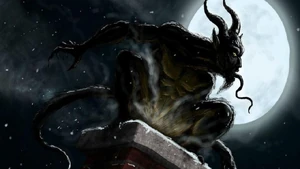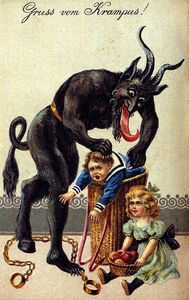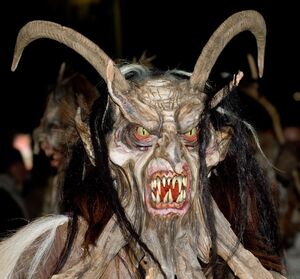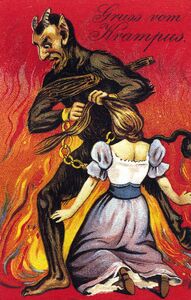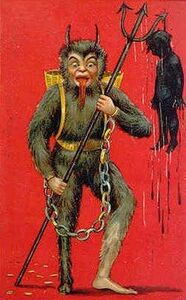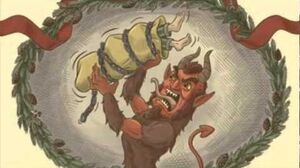Krampus, also known as the Christmas Devil and the Christmas Demon, is a demonic accomplice and the arch-nemesis of Saint Nicholas/Santa Claus, who appears in various legends within most European countries, most notably Austria and Hungary. He was used as a scare-them-straight figure by children's parents as a means to frightening them into obeying them lest they become the next victims of Krampus.
Appearance[]
According to folklore, Krampus is depicted as a creature that possesses a unique and unsettling appearance. He is often described as a peculiar combination of a goat and a demon, with his body being divided between these two distinct entities. His menacing presence is accentuated by his physical attributes, including a mixture of coarse hair that covers his body in varying shades of brown or black. Standing on two limbs, Krampus possesses an intriguing abnormality, as one of his limbs takes the form of a hoof, while the other resembles a foot. Adding to his eerie visage, his mouth is filled with razor-sharp fangs, which are accentuated by a long, pointed tongue that hangs provocatively from his mouth.
Krampus is often depicted carrying chains, which are believed to symbolize the Christian Church's ability to restrain and bind the Devil. He purposefully thrashes these chains to create a dramatic and intimidating effect. Alongside the chains, Krampus sometimes carries bells of different sizes. On the other hand, the 'Ruten', which are bundles of birch branches, have more pagan origins and are used by Krampus to occasionally swat misbehaving children. These birch branches may have held significance in pre-Christian pagan initiation ceremonies. In certain representations, the birch branches are substituted with a whip. Additionally, Krampus is sometimes portrayed with a sack or basket strapped to his back, serving the purpose of capturing and taking away wicked children to be either drowned, eaten, or transported to Hell. Similar stories can be found in the legends of other companions of Saint Nicholas, such as Zwarte Piet.
Origins[]
The true origins of the Krampus figure remain shrouded in mystery, leaving both folklorists and anthropologists puzzled. Various theories have been proposed, with some suggesting that it dates back to pre-Christian times. The history of this enigmatic figure has been traced back to ancient Alpine traditions, adding to its rich and intriguing lineage. In a seminal article published in 1958, Maurice Bruce delved into the depths of the Krampus phenomenon, shedding light on its fascinating background.
In 1975, anthropologist John J. Honigmann shared his intriguing observations during his time in Irdning, a quaint town nestled in the region of Styria. Honigmann noted that the presence of Krampus figures continued to endure throughout the years. Fascinatingly, he discovered that by the 17th century, Krampus had become intertwined with Christian winter festivities, as the tradition evolved to pair Krampus alongside the beloved figure of St. Nicholas. Many countries that were once part of the Habsburg Empire have adopted the custom of having Krampus join St. Nicholas on the 5th of December, a tradition that originated in Austria.
Over the past few years, there has been a growing trend on the internet regarding the belief that the Krampus, a mythical creature associated with Christmas, is the offspring of Hel, the Norse goddess who rules the underworld. This idea has gained significant attention and even made its way into reputable publications like National Geographic and Smithsonian Magazine. However, it is important to note that this connection is most likely a creation of Gerald Brom, a talented American artist and author known for his fantastical works. In his 2012 novel titled "Krampus the Yule Lord," Brom portrays Krampus as the main character, potentially sparking the idea of his lineage with Hel. Interestingly, this concept also surfaced shortly after in two online games developed by Funcom, a renowned Norwegian games producer.
Symbolism[]
The most common depiction of the Krampus is that it resembles something Devil-like (similar to The Devil in Abrahamic religions), goat-like (similar to the mythical demon Baphomet), or satyr-like (possibly similar to Pan, the Greek god of wilderness and rustic music) with more fur in his body. As a colleague of Saint Nick, Krampus is essentially the anti-Santa Claus in that he brings suffering and torture to naughty people whereas Santa brings gifts. Most versions of the Krampus depicts the Krampus almost as a Knight Templar character who would severely beat children into obedience, or, in some versions, outright kills the child. Krampus may even go as far as to kidnap the child and put them into a sack and take them back to his lair to devour them. Or, he simply takes them to the underworld. One of his main discipline tools includes birch sticks that he could use to swat children with.
It is customary to offer a Krampus schnapps referred to as a "Krampuslauf", a strong distilled fruit brandy. These runs may include Perchten, similarly wild pagan spirits of Germanic folklore and sometimes female in representation, although the Perchten are properly associated with the period between the winter solstice and January 6.
Europeans have been exchanging holiday greeting cards called "Krampuskarten" featuring Krampus since the 19th century. Sometimes introduced with "Gruß vom Krampus" ("Greetings from the Krampus"), the cards usually have funny and humorous rhymes and poems. Krampus is often featured looming menacingly over children. He is also shown as having one human foot and one cloven hoof. In some, Krampus has sexual overtones, as he is pictured pursuing buxom women. Over time, the representation of Krampus in the cards has changed; older versions have a more frightening Krampus, while modern versions have a cuter and more Cupid-like creature. Krampus has also adorned postcards and candy containers.
In Germany, there is a day called "Krampushaeht", or "Krampus Night", that would be celebrated on December 5, ironically on the same day as St. Nicholas Day. Nowadays, there are festivals and parades thrown for the Krampus, and many people dress up like him within most Alpine towns in events such as the Krampuslauf (translated in English as "Krampus Run").
According to the Alpine cultures, there were spirits called "Pektin" or "Pectin" (not to be confused with the structural molecule pectin). Some of these spirits are good and some of them are bad, and Krampus is most definitely one of the bad ones.
Gallery[]
Images[]
Videos[]
[]
| | ||
|
Main Icons Others | ||

